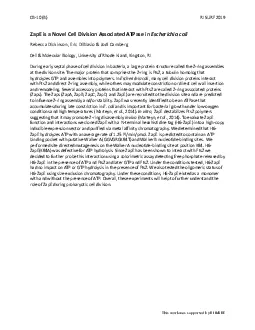

CB10BRI SURF 2019ThisRI INBREZapE is a Novel Cell Division Associated ATPase in Escherichia coliRebeccaDickinsonEricDiBiasioJodiCambergCell Molecular BiologyUniversity of Rhode IslandKingston RIDuri ID: 870111
Download Pdf The PPT/PDF document "work was supported by" is the property of its rightful owner. Permission is granted to download and print the materials on this web site for personal, non-commercial use only, and to display it on your personal computer provided you do not modify the materials and that you retain all copyright notices contained in the materials. By downloading content from our website, you accept the terms of this agreement.
1 CB - 10 ( B ) RI SURF 2019 This
CB - 10 ( B ) RI SURF 2019 This work was supported by RI INBRE ZapE is a Novel Cell Division A ssociated ATPase i n Escherichia coli Rebecca Dickinson , Eric DiBiasio & Jodi Camberg Cell & Molecular Biology , University of Rhode Island , Kingston, RI During early septal phase of cell division in bacteria, a large protein structure called the Z - ring assembles at the division site. The major protein that comprises the Z - ring is FtsZ, a tubulin homolog that hydrolyzes GTP and assembles into polymers. In E scherichia coli , many cell division proteins interact with FtsZ and direct Z - ring assembly, while others may modulate constriction or direct cell wall insertion and remodeling. Several accessory proteins that interact with FtsZ are called Z - ring associated proteins (Zaps). The Zaps (ZapA, ZapB, ZapC, ZapD, and ZapE) are recruited to the division site and are predicted to influence Z - ring assembly and/or stability. ZapE was recently identified to be an ATPase that accumulates during late constriction in E. c oli and is important for bacterial growth under low - oxygen conditions and high temperatures (Marteyn, et al. , 2014). In vitro , ZapE destabilizes FtsZ polymers suggesting that it may promote Z - ring disassembly in vivo (Marteyn, et al. , 2014). To evaluate Za pE function and interactions we cloned ZapE with a N - terminal hexahistidine tag (H6 - ZapE) into a high - copy inducible expression vector and purified via metal affinity chromatography. We determined that H6 - ZapE hydrolyzes ATP with an average rate of 1.25 Pi /min/pmol. ZapE is predicted to contain an ATP binding pocket with putative Walker A (GGVGRGK84T) and Walker B nucleotide - binding sites. We performed site directed mutagenesis on the Walker A nucleotide - binding site at position K84. H6 - ZapE(K84A) was defe ctive for ATP hydrolysis. Since ZapE has been shown to interact with FtsZ we decided to further probe this interaction using a colorimetric assay detecting free phosphate released by H6 - ZapE in the presence of ATP and FtsZ and later GTP and FtsZ. Under the conditions tested, H6 - ZapE had no impact on ATP or GTP hydrolysis in the presence of FtsZ. We also tested the oligomeric status of H6 - ZapE using size exclusion chromatography. Under these conditions, H6 - ZapE eluted as a monomer with and without the presen ce of ATP. Overall, these experiments will help to further understand the role of ZapE during prokaryotic cell division.